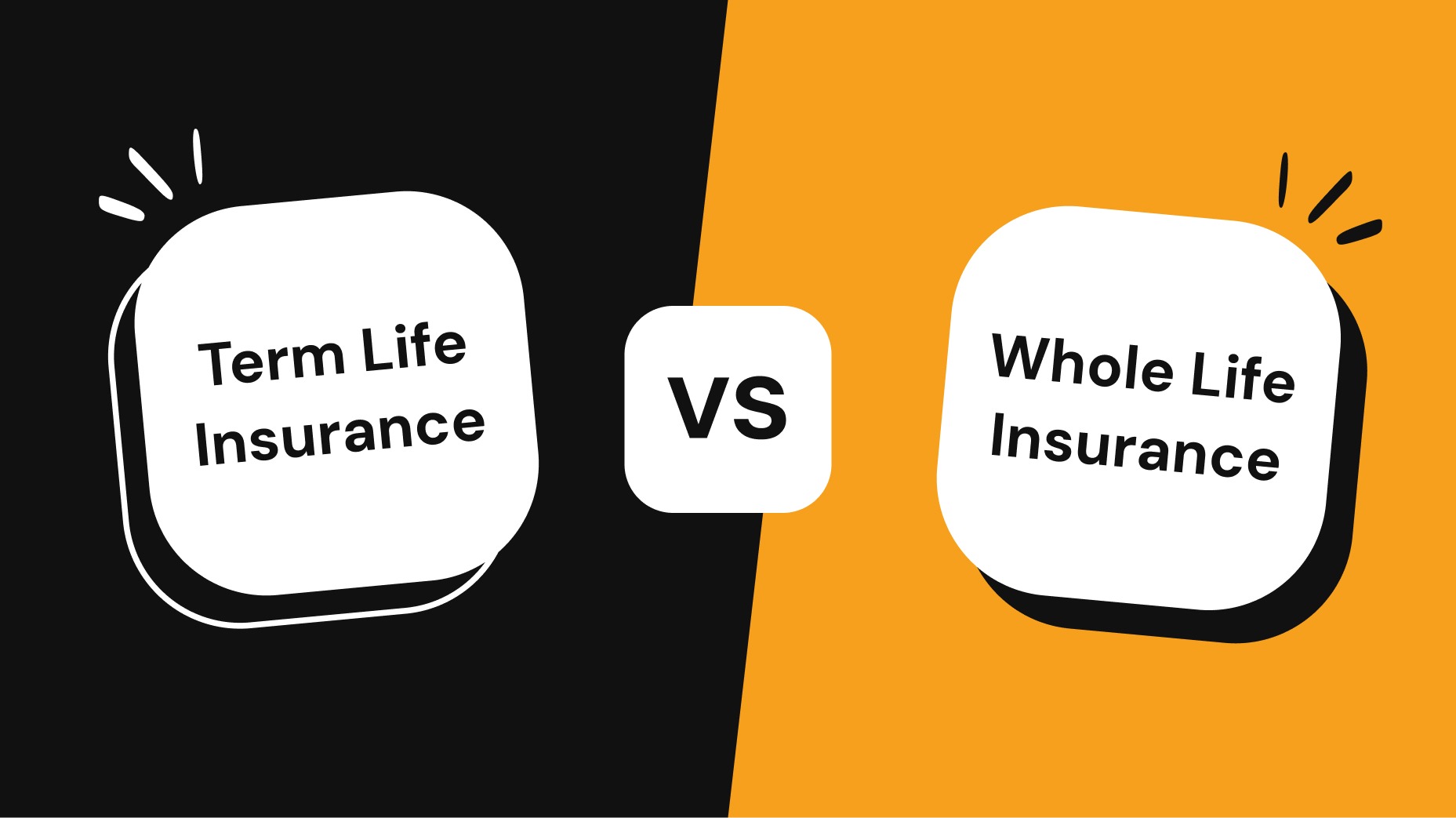Introduction
When it comes to protecting your loved ones financially, life insurance is one of the smartest decisions you can make. But there’s one question that confuses almost everyone — Term vs. Whole Life Insurance: Which Policy Is Right for You?
Both options serve the same purpose — ensuring your family’s financial stability in case of an unfortunate event. Yet, they differ in cost, coverage duration, benefits, and cash value. Understanding these differences is crucial before signing that policy document.
In this guide, we’ll break down everything about term life insurance vs whole life insurance, explain the pros and cons of each, and help you decide which suits your life goals and financial situation best.
1. What Is Term Life Insurance?
Term life insurance provides coverage for a fixed period — usually 10, 20, or 30 years. If the policyholder passes away during this term, the beneficiaries receive a death benefit. However, if you outlive the term, there’s no payout, and the policy expires unless you renew it.
Example:
Imagine a 30-year-old buying a 20-year term plan for $500,000. If they pass away during the policy term, their family receives $500,000. If they live beyond those 20 years, the policy ends with no maturity benefit.
Key Features
- Affordable premiums
- Fixed coverage duration
- No cash value component
- Option to convert to permanent insurance (in some cases)
2. What Is Whole Life Insurance?
Whole life insurance, as the name suggests, offers lifetime coverage. It not only provides a death benefit but also builds cash value over time — a unique savings component that grows tax-deferred.
The premiums are higher than term policies, but the policy never expires as long as you continue paying.
Key Features
- Lifetime coverage
- Guaranteed death benefit
- Builds cash value
- Fixed premiums throughout your life
Example:
If you buy a $500,000 whole life policy at age 30 and keep paying premiums, you’ll remain insured for your entire life. Plus, you can borrow or withdraw from the cash value account during your lifetime.
3. Term Life Insurance vs Whole Life Insurance: The Core Difference
Let’s dive deeper into the real differences that set these two apart.
| Feature | Term Life Insurance | Whole Life Insurance |
|---|---|---|
| Coverage Duration | Fixed (10–30 years) | Lifetime |
| Premiums | Lower | Higher |
| Cash Value | None | Builds over time |
| Flexibility | Renewable or convertible | Permanent |
| Purpose | Temporary protection | Long-term wealth & legacy planning |
This comparison helps you understand term life insurance vs whole life insurance at a glance — one is simple and temporary, while the other is complex but permanent.
4. Cost Comparison: Term Life vs Whole Life Cost
One of the biggest deciding factors is cost. Term life insurance is often 5 to 15 times cheaper than whole life for the same coverage amount.
Example:
- A healthy 30-year-old male might pay $25/month for a $500,000 term policy (20 years).
- The same person could pay $300/month for a $500,000 whole life policy.
That’s why many young adults choose term coverage — it fits tighter budgets while still offering strong financial protection.
However, with whole life insurance, part of your premium goes toward building cash value, which can later be borrowed or withdrawn. So, while expensive upfront, it can serve as a financial asset later in life.
5. Cash Value Explained: Term Life vs Whole Life Cash Value
This is where whole life insurance really stands apart.
Term life policies have no cash value — you simply pay premiums for pure protection.
Whole life, on the other hand, functions like a dual-purpose product — part insurance, part investment.
Over time, your premium payments contribute to a cash value account that grows based on a guaranteed interest rate. You can even borrow against it or withdraw funds if needed.
However, loans or withdrawals reduce the death benefit if not repaid.
6. Understanding Benefits: Term Life vs Whole Life Benefits
When deciding between the two, it’s crucial to weigh their advantages.
Term Life Insurance Advantages
- Low premiums for high coverage
- Simple to understand and manage
- Ideal for young families or mortgage protection
- Can convert to whole life in some cases
- Best for short-term financial goals
Whole Life Insurance Advantages
- Lifetime coverage without expiration
- Builds cash value that grows tax-deferred
- Can serve as collateral for loans
- Fixed premiums — no surprises
- Ideal for long-term wealth planning
Each policy serves different needs. The term vs whole life policy choice depends on whether you want affordable protection now or a lifelong asset that grows in value.
7. Which Is Better: Term or Whole Life Insurance?
The answer depends entirely on your personal and financial situation.
If you’re young, healthy, and focused on affordability, term insurance might be your best bet.
If you want lifelong protection, wealth transfer benefits, and peace of mind — whole life makes more sense.
Think of it this way:
- Buy term if: You want large coverage at a low cost while raising a family or paying off debt.
- Buy whole life if: You want guaranteed lifetime security, cash accumulation, and estate planning advantages.
8. The Smart Hybrid Approach
Many financial advisors recommend a combination strategy. You can buy a base whole life policy for lifelong coverage and add term insurance for extra protection during high-responsibility years (like paying off loans or raising kids).
This hybrid method offers balance — affordability now, with guaranteed protection later.
9. Common Myths About Term and Whole Life Policies
Myth 1: Term life is a waste because you get nothing back.
Truth: While it has no maturity benefit, term insurance gives massive coverage at low cost — crucial for income protection.
Myth 2: Whole life is only for the rich.
Truth: Anyone who wants lifelong security and disciplined savings can benefit.
Myth 3: It’s too late to buy life insurance after 40.
Truth: You can buy or renew coverage even in your 50s or 60s — premiums increase but protection is still possible.
10. Real-World Scenarios
Scenario 1:
Sarah, age 28, wants affordable coverage while paying her student loans. She chooses term life for 20 years at $25/month.
→ Her family gets $500,000 protection without straining her budget.
Scenario 2:
David, age 40, wants to leave a legacy for his children and grow savings. He chooses whole life, paying $300/month.
→ His policy accumulates cash value, and his kids are financially protected for life.
11. Tax and Investment Benefits
Whole life policies come with tax advantages — the cash value grows tax-deferred, and loans are generally tax-free. Death benefits are also usually exempt from income tax.
Term life doesn’t offer these investment benefits but serves pure protection purposes. For many, that’s all they need.
12. How to Choose Between Term vs Whole Life Policy
Ask yourself:
- What’s my budget for insurance?
- How long do I need coverage?
- Do I want a savings component or just protection?
- What are my family’s financial goals after I’m gone?
If your goal is to cover your family during your income-earning years, term life fits.
If you want lifelong protection and to build a financial legacy, whole life wins.
13. Expert Tip: Review Regularly
Whichever plan you choose, review your policy every few years. Life events like marriage, children, or career changes can shift your insurance needs. A quick review helps ensure your coverage matches your evolving lifestyle.
14. Final Thoughts
Deciding between term life insurance vs whole life insurance isn’t about which one is universally “better” — it’s about what’s better for you.
If you value flexibility, low cost, and simplicity — go with term life.
If you want permanence, savings, and peace of mind — whole life is your answer.
Whichever you choose, make sure it aligns with your goals, budget, and the future you want to secure.
FAQs
Term life offers protection for a specific period, while whole life provides lifetime coverage and builds cash value.
For young adults with limited budgets, term life is ideal due to its low premiums and high coverage.
Yes. Whole life insurance accumulates cash value over time, which can be borrowed or withdrawn.
Many insurers offer the option to convert a term plan to whole life before the term expires — without a new medical exam.

